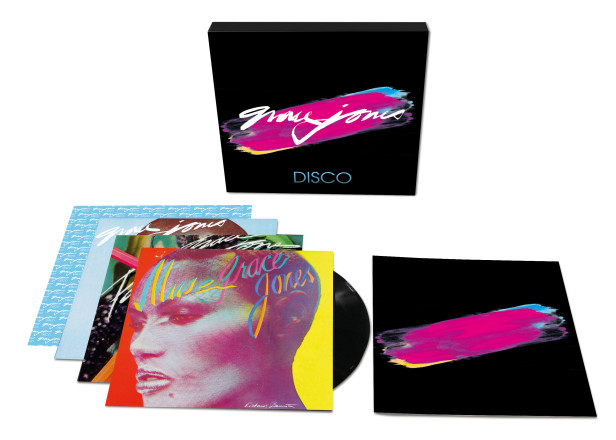1977 was an important year according to most people I know, and many I don’t. The first Star Wars film was screened, The first issue of 2000AD was published, Apple was incorporated, the rings of uranus were discovered (much to the amusement of most), Led Zeppelin and Elvis Presley played their last concerts, Elvis then died along with, most notably yet not exclusively, Marc Bolan and Groucho Marx and many many fine albums were released including Never mind the Bollocks, Rumours by Fleetwood Mac, Damned Damned Damned by the Damned, Saturday Night Fever, The Clash, New Boots and Panties by Ian Dury, A farewell to Kings by Rush and Heroes by Bowie to name but a few…I can hear some of you shouting at me already about the ones I’ve missed.
A couple of albums that deserve more mention than they enjoyed in this picvotal year are The best of Top of the Pops ’77 which was entitled ‘Top of the Poppers’, a pre amyl-nitrate compilation and Portfolio by Grace Jones.
Portfolio was Jones’ debut album and opened with a brass reconstruction of lean on me with a kitsch key-change before the strange and androgenous twenty-nine year old, originally from Spanish Town Jamaica, launches into the lyrics for ‘Send in the clowns’ from Stephen Sondheim’s Broadway show ‘A little night music’, backed by just a little more funk than the original 1973 versions by both Judy Collins and Frank Sinatra. The track, at seven and a half minutes, outplayed most of the records of its era by a good five minutes but it set the scene for something that was happening at the Loft, Studio 54 and in many other discotheques across America. Disco had arrived to counteract punk and rock and grind the stiffness and compliance of the sixties into a long line of white powder.
Jones was pivotal in this moment and movement in the downtown NYC scene and famously hosted the Studio 54 party in 1977 to which Nile Rodgers and Bernard Edwards were denied entry…they went home and wrote Le Freak.
Back to portfolio and Jones continued her Broadway theme with two other ‘up-funked’ tracks in her own enimitable and often slightly tuneless, but nevertheless exciting style; ‘What I did for love’ from ‘A chorus line’ and ‘Tomorrow’ from ‘Annie’. Next, and the start of the B side on the original vinyl pressing, a seven minute interpretation of Edith Piafs ‘La Vie en Rose’ complete with cowbells persuaded most that it was ok to think that this amazonian model-turned recording artist was actually quite sexy.
The last three tracks on Portfolio were new material, two of which (‘Sorry’ and ‘That’s the trouble’) were co-written by Jones with the albums producer Tom Moulton, the ‘father of the disco mix’. The album ended with ‘I need a man’ which became Jones’s first club hit and reached number One on the Billboard dance chart whilst setting the precidence for gay anthems in a scene that released a generation from their chains.
Riding on the wave of her debut success, Jones and Moulton went straight back into the legendary Sigma-Sound studios in Philadelphia to record ‘Fame’, her second album. Like Portfolio, the A side was a continuous medley of camp disco tracks whilst side B again began with a reinterpretation of a French Classic – Jacques Prevert’s “Les Feuilles mortes”, sung in English as “Autumn Leaves”. Many before and since Jones have covered and reworked this 1945 masterpiece including Patti Page, Joan Baez, Coldcut, The Tiger Lillies, Eva Cassidy, Iggy Pop, Bob Dylan and Eric Clapton.
Released in 1978, just nine months after Portfolio, Fame went to number 10 on both the US Hot Dance Club Play charts and Canadian urban charts. Jones’s vocal had become more melodic and her lyrics, her style and her stance, physically and psychologically, were creating an icon in the dance milieu of the late seventies
Muse, Jones and Moultons last disco album, was released in 1979 and followed the theme of the previous two albums with a continuous theme on the A side and unrelated tracks on the ‘B’. Unfortunately the album came out around the same time as the anti-disco backlash and went almost unnoticed by both her fans and new-listeners alike who were either turning to Hip Hop or rehab as the eighties appeared over the horizon. Muse remains Jones’s lowest-charting album in the U.S. and her only album to not produce any charting singles, it is generally referred to as her ‘lost album’.
Although aficionados usually refer to Jones’ 80’s Compass Point Sessions, named due to her collaborations with the Compass Point Allstars, as her most important and creative period, her first three albums and her influence in the birth of the disco scene has finally been recognised and celebrated with the release of ‘Grace Jones: The Disco Years’, a sleek box-set of these three sometimes camp but always danceworthy albums coupled with a host of bonus B-sides, edits, instrumentals and in-era and extended mixes, some previously unreleased and all lovingly remastered.
New sleeve notes, extended artwork from long-time collaborator Richard bernstein and the choice of CD or vinyl formats makes this a must for disco junkies as well for fans of Jones’ later fusion of New-Wave and Reggae, for which she is, until May 4th when the box set is released, better known.














No Comment